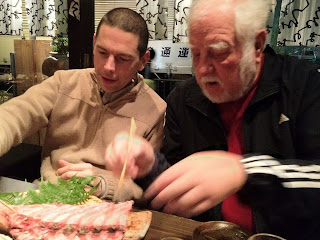The three remaining kokusai senshusei: Akimoto, Ma-i-ku, (me) and Masa, following our graduation ceremony.
After taking a final written test, submitting an essay, and completing a final shinsa including kihon dosa, kamae, shitei waza, jiu waza, and self defence technique, I have successfully completed the senshusei course.
Celebrating this time with Yoshioka, who graduated from the kenshusei program on the same day.
A newly arrived senshusei took this picture of my back after we did a lot of koho ukemi. My back was by far the most susceptible to becoming abbraided from that exercise.
With a top sumo wrestler. On that day, Yoshioka took us to visit a sumo stable. We had to be there by 6am to watch them practice. This was an incredible experience because it was so intimate. We knelt silently and watched them practice for 2-3 hrs. The first part was mainly grueling strength and conditioning training, and at the end they wrestled, which was incredible. I could not believe the sound their heads made when they occasionally crashed into each other.
During the beautiful week when the Cherry trees bloom, I am pictured here with the Kuromizu and Hirayama family.
My haiku:
Sakura flowers
cloak each branch like drifts of snow.
All too soon, they fall






















